Information
Across the Eurasian: Meeting Minutes of the International Symposium on the Bronze Age of the Area from the Mount Tianshan to the Altai Mountains
Translated by Zhao Jinchao
New archaeological discoveries at Central Asia and Xinjiang
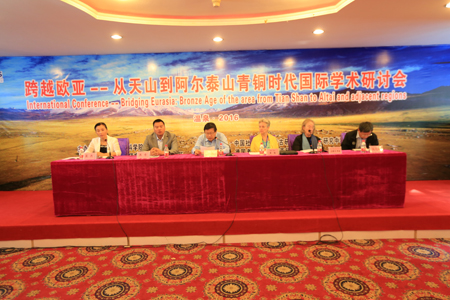
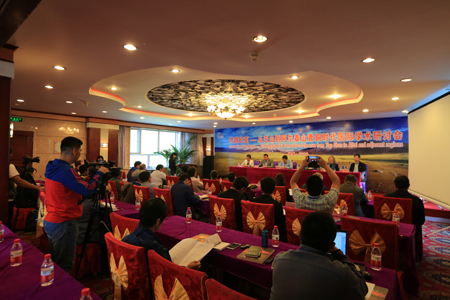
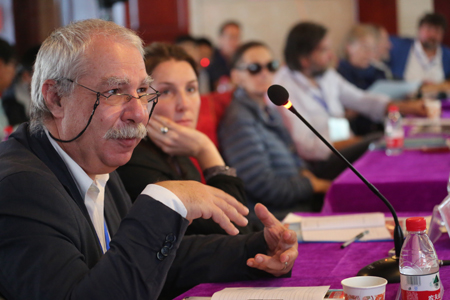
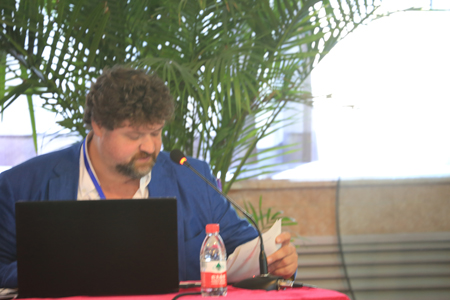
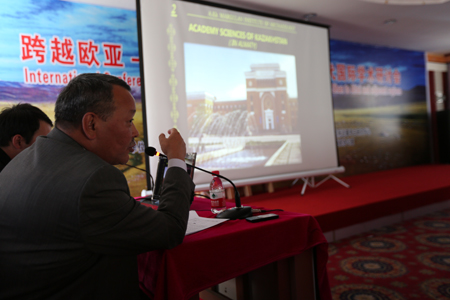
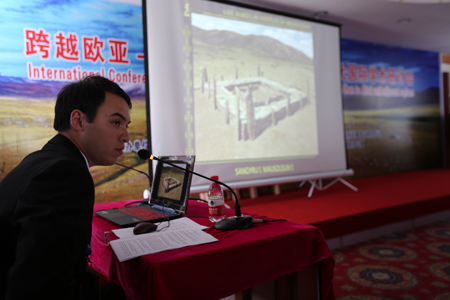
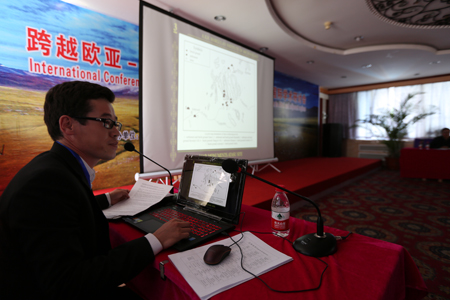
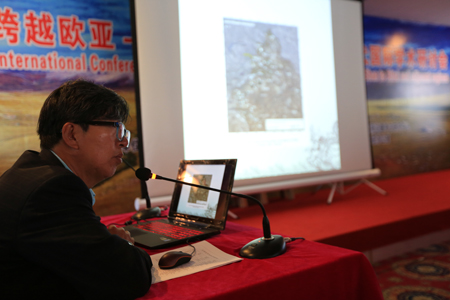
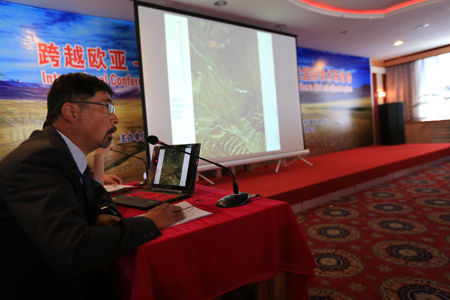
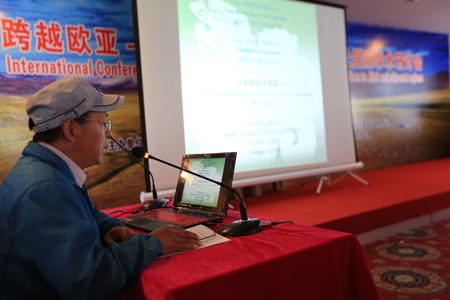
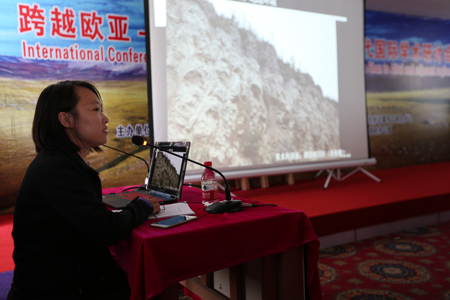
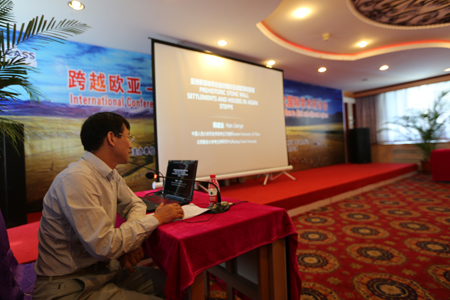
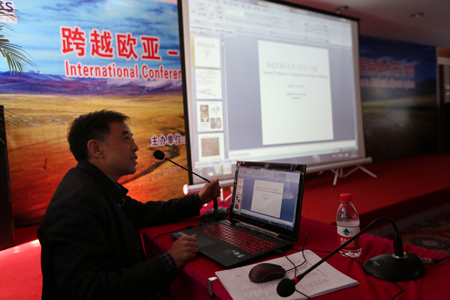
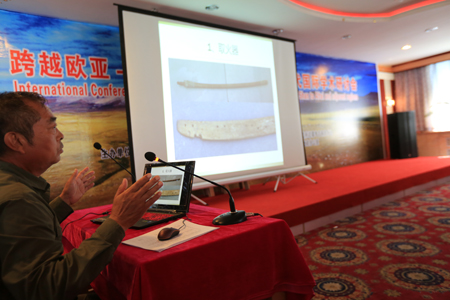
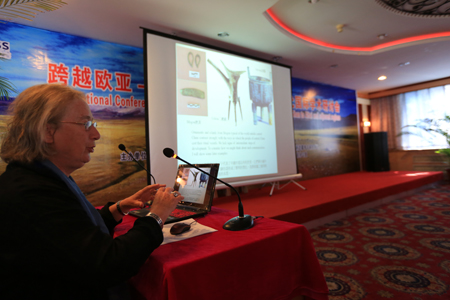
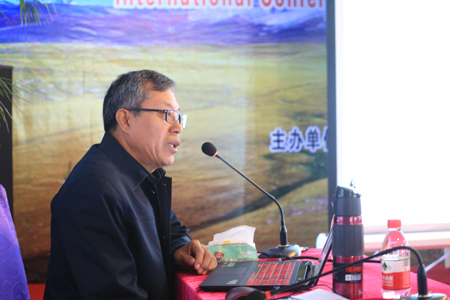
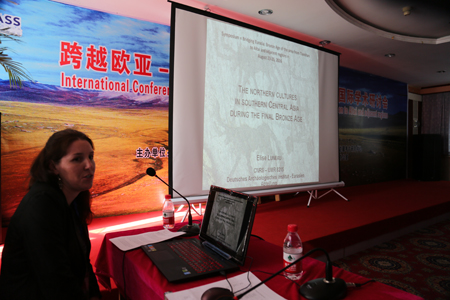
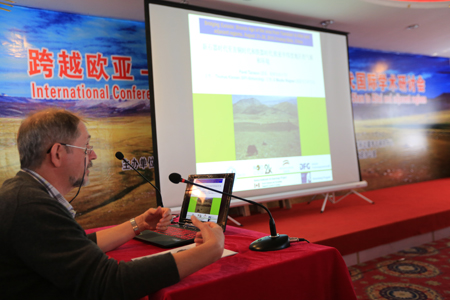
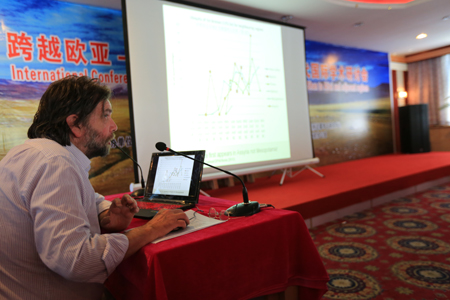
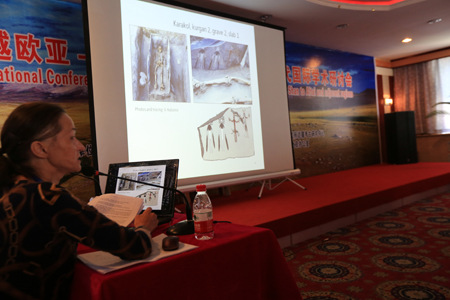
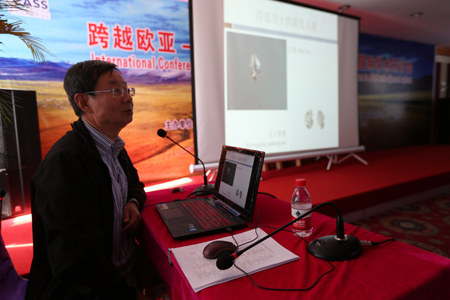
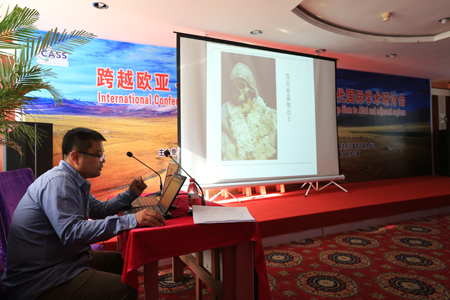
Titled “New Discoveries in
Central Asian Sites from the late Bronze Age to the Iron Age,” the talk given
by Professor Nikolaus Boroffka from the German Archaeological Institute focused
on the site Molali of the late Bronze Age and Bandikhan of the early Iron Age,
which were excavated at the southern Uzbekistan. Sit Molali shows typical
features of the Bactria-Margiana Archaeological Complex (namely Daxia in Chinese historical sources). Its
castle-shaped architecture surrounded by two-layered adobe walls is not
commonly seen in the southern part of Central Asia. Excavations at the site Bandikhan
shed light on the study of hand-made painted potteries of the Yaz I
Civilization. Remains of potteries, metal works, and stone implements reveal
that this site perhaps once had a close connection with the larger region of
the southern Central Asia, and even the western region of China.
In the report titled “The
Archaeological Excavation in Saridzhar and Karimberdy of the Southern
Tajikistan,” Doctor Mike Teufer from the German Archaeological Institute
focused on the study of the late Bronze Age site Saridzhar and Karimberdy of
the early Iron Age in the southern Tajikistan. No matter from the perspective
of chronology or typology, findings from the two sites show distinct successive
relationship. The excavation of painted potteries from the upper layer of
Saridzhar particularly shows the shift of taste from the plain pottery in the
late Bronze Age to the painted pottery in the early Iron Age. Teufer also
pointed out that painted potteries from Karimberdy bear some relations to the
early Painted-Pottery Culture of Xinjiang.
Three archaeologists from the
Margulan Institute of Archaeology of Kazakhstan introduced the burial site of Begazy, Phase I
and III burial sites of Sangyru, and the excavations at Atasu region.
The talk given by Professor Arman
Beisenov was named “The Burial site of Begazy in the Central Kazakhstan.”
Begazy is located close to the Mount Begazy, which is 240 km away to the
southeast of the city Karaganda of the central Kazakhastan. The site is
comprised of 50 tombs of the Andronovo Culture, 6 of the Begazy-Dandybai
Culture, 10 of the Saka period, and more than 200 dated to the Kazakh Khanate.
From 1947 to 1952, the renowned archaeologist Alkay•Margulan excavated
18 tombs of the Andronovo Culture and all of the 6 tombs of the Begazy-Dandybai
Culture. The Begazy-Dandybai was named by Margulan according to his research of
materials found in relative burial sites. Beisenov primarily introduced the
condition of Begazy-Dandybai tombs and his opinions on the periodization of the
site. He argued that those tombs were constructed during the final phase of the
Begazy-Dandybai Culture, as potteries found there showed a strong feature of
the late Bronze Age. His argument is confirmed by the C-14 data which dates the
objects to the time span ranging from the eleventh to ninth century BC.
Beisenov further pointed out that the cloister structure found at the eastern
part of Begazy-Dandybai site was perhaps the prototype of the tomb passages of
the Saka reign and its succeeding periods.
Doctor Islam Akhjyarov presented under
the title “The Burial Sites of Sangyru I and III—Cultural Remains of
Begazy-Dandybai Culture at Central Kazakhstan.” The two sites are located close
to the Sangyru Villiage, which is 300 km away to the south of the city
Karaganda. In 1953 and 1964, Alkay•Margulan has excavated
the site and found more than 10 tombs. 2014, a team led by Arman Beisenov conducted
clear-up and recovery works of the site. Different from other burial sites of
Begazy, tombs of this site belongs to the early phase of the Begazy-Dandybai
Culture. Typological study and C-14 test dated this site to the period between
the 15th and 13th century BC.
Titled “The Archaeological Region at Atasu of the Central Kazakhstan,”
Doctor Daniyar Duisenbay introduced sites located at Atasu Region. 300 km far
away to the south of the city Karaganda, Atasu region includes the burial site
of Atasu, and other archaeological sites from the Bronze Age to modern times,
part of which has been excavated and studied comprehensively. The region bears
remarkable significance for the archaeological research of the central
Kazakhstan and even the entire Kazakhstan.
Researcher Cong Dexin, Jia Xiaobing, and Guowu from the Archaeological
Institute of the Chinese Academy of Social Sciences introduced the most recent
discoveries respectively.
Researcher Cong Dexin introduced recent discoveries at the site Aduun
Chuluu in his talk titled “The Bronze Culture of the Western Tianshan Area from
the Perspective of Eurasian Steppes.” He contended that excavated tombs,
residential remains, and rock paintings indicated to the existence of a
regional culture—the Aduun Chuluu Culture. As one of the earliest known site of
Bronze Age at the western Tianshan area, Aduun Chuluu reveals how the social
structure has been complicated. Research along the Bortala River found a large
number of sites that bear similar organizational structures with Aduun Chuluu.
This region is a significant bridge for linking the Tianshan and Altay areas.
Titled “The Husita Site and the Early Bronze Age of the Bortala River
Valley,” Researcher Jia Xiaobing’s report introduced the most recent discoveries
at Husita and the preliminary study of the layout of the Bortala human
settlement. The site Husita is comprised of settlement area, burial site, and
military observatory. Excavations of the settlement area in front of the Mount
Husita and Heshantou found large area of house foundations made primarily by
stone, and pieces of potteries, stonewares, and bronze vessels. Jia further
classified the Bronze Age sites of the Bortala River Valley into three levels
ranking from the large, middle, to the small scale by applying the GIS
(Geographyical Information System) for interpretations, and pointed out that
there were once multiple types of settlement patterns at the upstream area of
Bortala River.
Researcher Guo Wu focused on the
excavation taken place in the recent three quarters at the site Sandao Haizi of
Qinghe County in Xinjiang in his talk titled “The New Archaeological
Discoveries and Research on the Site Sandao Haizi of Qinghe County.” The
excavation centered on the site No. 3 of Hua Haizi, as well as a number of
small and medium sized sites in its surrrounding area. The team found and
confirmed the remains of deer stones, shield stones, wooden-frameworks found at
the center of the stone mound, pieces of human bones, sheep teech, timber piles,
and so on. The initial construction time of the site was dated to the ninth
century BC. Researchers speculated that the site has been used for ritual
services, and was perhaps constructed by the group of people who built the
large-scaled cemetery found at Arzan in the Tuva Republic of Russia. Site
Sandao Haizi has served as the summer ritual center for this early nomadic
society. The excavation is siginificant for studying the social-economic
evolution of Eurasian steppes, as well as the function of large-scaled ritual
practices in the development of complex societies.
Professor Chen Xiaoxia from the Department of Archaeology of the Renmin
University of China introduced the excavations taken places at the site
Quanshuigou and Dumuduebudege, which is located at the downstream area of
Bortala River in her report. Even though the cultural remains are not rich at
Quanshuigou, this site marks the earliest appearance of a burial structure
which is first built by foundation trenches and then filled with earth and
stones. This site is important for understanding the Bronze Age culture of the
region comprehensively. The Dumuduebudege site is featured by the remains dated
to the early Iron Age. Except for stone-mound tombs, the triangle foundation of
a stone-constructed city is also rare seen for the same period.
Regional studies
Regional studies concentrated on the commodity articulation and technology
transmission within the eastern region of the Eurasia. Studies on the formation
and lifestyle of nomadic groups, and their relationships with agricultural
people are also hot issues of this conference.
Professor Han Jianye from the Renmin University of China focused studying
the stone-walled settlement sites and houses of the per-history period of the
Asian Steppe Region. He proposed a classification which divided the history
from the 3000 to 1000 BC of the stone-walled settlement sites and houses of the
Asian Steppe into two regions and four periods. It is not clear yet if there
was conncetions of the stone-wall remains between the east and the west region,
although the interaction among stone-walled settlements
within a region is confirmed. The distribution range of settlements and houses
was extended through ages. Most of the stone-walled settlements did not
function as the central settlement, but related to some extent to the military
defence system.
Professor Liu Xuetang from the Xinjiang Normal University presented a
paper titled “Several Issues of the Archaeology of the Bronze Age of Xinjiang.”
Through the perspective of examining rock paintings of Kangjia Shimenzi,
xu-patterned potteries, and potteries with grooved and pressed patterns, and
collecting abundant written resources and images, Liu pointed out that some
cultural features of the Bronze Age Xinjiang culture show similarities to
Central Asia, West Asia, and even the Europe. Themes of the Kangjia Shimenzi
rock paintings are very similar to the Xiaohe Cemetery of Xinjiang in terms of
the implements, decorations, and cultural worships. They were perhaps
constructed by people from the same culture. The design of the un-patterned
potteries originated in Ukraine region and then articulated to the northern
steppes till the Xianbei period. The grooved and pressed patterns on potteries
have been localized after its arrival at Xinjiang, but remained subordinate.
In his talk on “Study
of the Implements of early nomads in Xinjiang,” Researcher Lv Enguo from the
Xinjiang Institute of Archaeology discussed about the naming and the usage of
more than ten implements made in the pre-historical period at the Turfan region
of Xinjiang. These implements have been usually misnamed or ignored. Located at
the eastern basin of the Mount Tianshan, the Turfan region is renowned for its
well preservation of ancient remians due to its unique geographical environment
and the dry climate. Mr. Lv provided a splendid classification and research of
the tools of making fire through drilling wood, wooden stirring sticks, wooden
boomerangs, arrows and bows, stone make-up sticks, arm-covers for shooting,
small tools for untying ropes, seashells, bells made from shins, decorated
buckles, burnishing tools, and crowns that are typical in Turfan and closely
related to the daily life of nomads. Studies on wooden boomerangs and make-up
sticks show connections with Central Asia, and correct the false in previous
namings.
Professor Jessica Rawson from the Oxford University gave a talk titled “From
the Eurasia Steppes to the Northern China: the Transmission of Technology.” She
argued that the shapes, functions, and symbolic meanings of nomadic implements
have been consistently shifted through ages during the transmission and
articulation of them from the border areas to the agricultural settled society.
The shift is caused by the change of factors including raw material reserves,
craftsmenships, and lifestyles. This shift at the same time represents how
tight are the commodities articulation and technological interactiions between
nomads and agricultural people.
Professor Jia Weiming from the University of Sydney of Austrilia presented
under the title “The Archaeological Study of the Transformation between
Agriculture and Husbandry—Taking the Research on the Upstream Area of the
Bortala River of the Wenquan County in Xinjiang as an Example,” and provided
new perspectives of studying the burial site complex, particularly the site
Aduun Chuluu of Wenquan County in Xinjiang by using datas of the ethnological
investigations. Regarding the geographical environment, the site Aduun Chuluu
represents an economic mode that is centered on livestocks, as it is located
far away from water sources and farmlands. From the perspective of
architectural form, the stone structure found in the site Aduun Chuluu has many
similarities with the campsites of modern herdsmen. Based on these information,
Jia proposed that the site is used as a fixed seasonal settlement. People from
the mountainous region applied distinct production models in different areas.
He further argued that this settlement type marked the beginning of the
transformation from the pure husbandry to the rotated grazing.
Doctor Elise Luneau from the
German Archaeological Institute introduced current research of international
academia on the Andronovo Culture in her talk titled “The Andronovo
Culture in the Southern Central Asia.” She pointed out that the Andronovo
people already had fixed population in the southern Central Asia, and
established communications among various ethnic groups, although it remains
unclear that if there were interactions except for possible commercial
contacts. Recent archaeological research in Turkmenistan revealed that the
temporal inhabitants already planted and consumed the same crops as the settled
cultural groups regardless of their nomadic features. The research of the plant
archaeology did not exclude the existence of a semi-farming and semi-husbandry
mode of the region. Nevertheless, mainstream scholarship considered that the
similarity of crops stemmed from the barter economy between the nomads and the
settled people.

执笔:陈晓程、刘彬彬、王鹏
摄影:尚国军
Category: English
News
Information
Key words:
